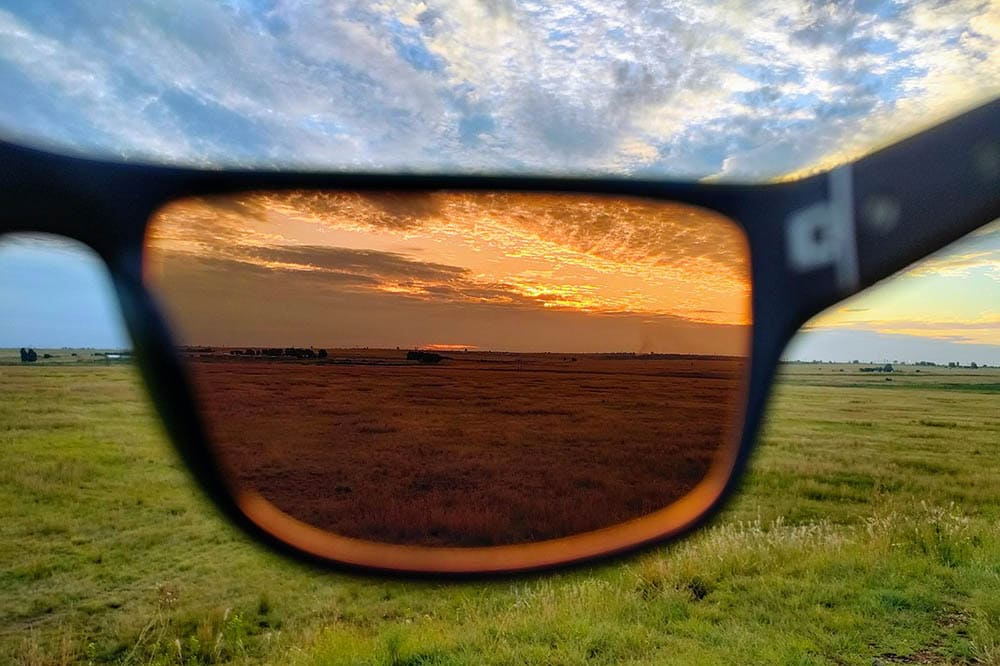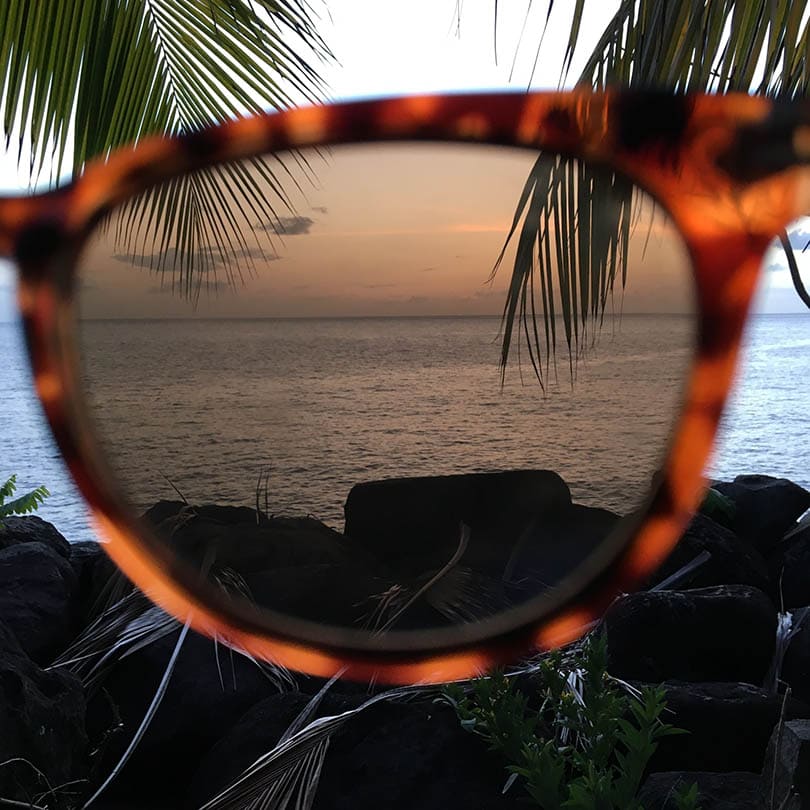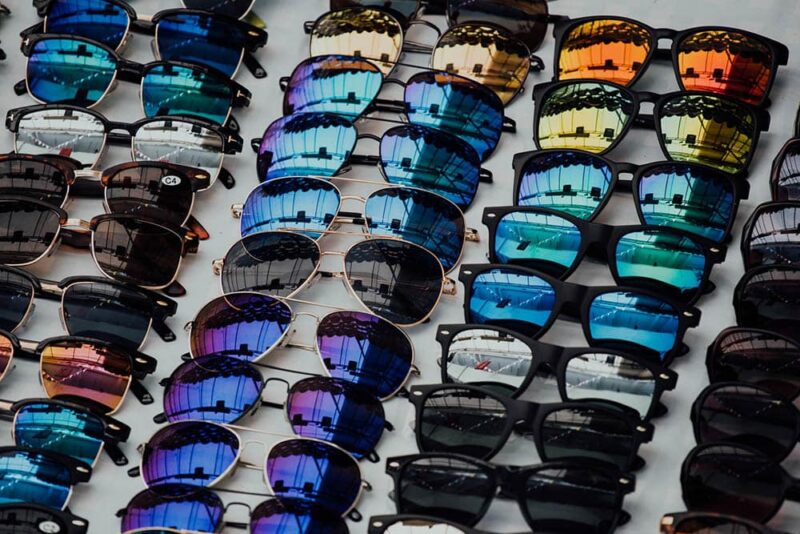What Are Polarized Sunglasses? How Do They Work?
Last Updated on

If you enjoy spending time outdoors or have eyes sensitive to bright light, you might own a pair of polarized sunglasses. While some people might be familiar with polarized sunglasses, others might not know the difference between them and standard sunglasses. In this article, we will get into the basics of polarized sunglasses, how they work, their benefits, and their drawbacks.

How Do Polarized Sunglasses Work?
Standard sunglasses lower the overall amount of light that reaches the eyes. However, they do not nullify the glare from the sun. Polarized sunglasses also reduce glare created by light reflected from the water’s surface, some polished surfaces, windshields, wet roads, and any other surface effective at reflecting light.
Polarized lenses reduce glare and improve visual clearness and comfort by making pictures look sharper and clearer. Lenses in polarized sunglasses are not just some typical glass lenses. A particular coating is added to the lenses to limit the light coming through, but not all light is limited. The coating limits only horizontal light while vertical light is allowed to pass thru. Polarized lenses do not provide extra UV protection as traditional 100% UV lenses. However, they can help you see more clearly and accurately while also reducing eye strain.
Lenses can be polarized in various methods and to different extents. For example, most low-cost polarized sunglasses have a thin coating on one side of the lens. In contrast, on higher-quality glasses, the coating is placed between two layers of lens material in lenses to protect it from scratching or rubbing off; the denser the coating, the better polarization.

Different Types of Polarized Glasses
When talking about polarized glasses, their difference lies in the lens tints. They come in six different colors, and each one represents an additional benefit. Darker colors are better in low-light conditions, while lighter ones are better suited for situations where we encounter more glare from reflections.
- Brown: Helpful in everyday situations since it increases contrast and performs well in brighter environments, but of the six, this one is the least effective for reducing glare. However, as it can reduce glare, it is still considered a fashion accessory.
- Gray: A good choice for everyday usage since it reduces strain on the eyes, improves color recognition, and reduces glare.
- Green: Ideal for various uses; it provides a consistent color impression, enhances shadows, and provides excellent contrast. Golfers prefer wearing them.
- Blue: People who tend to get up early and encounter fog or cloudy weather chose this color for their lenses because of its ability to define edges and improve color recognition. In addition, it is the most fashionable and visually attractive.
- Pink: Suitable for almost any weather condition. Cyclists and drivers like using them because they reduce eye strain and improve the colors seen and visual depth.
- Yellow: Good for mountain biking and shooting because bikers are required to focus for a longer period. It also helps avoid headaches and eye fatigue by filtering blue light from modern gadgets.

What Are Polarized Lenses?
If it’s a sunny day outside and you’re finding it difficult to see straight because of how bright the environment is, it’s because the light rays from the sun are very intense. They might be bouncing directly into your eyes off of water or metallic surfaces, or you may be facing the sun.
Polarized lenses make use of a special coating that’s layered onto the glass. This ‘filter’ makes it so that sunlight and reflections are reduced, which helps protect your eyes. This is done by removing horizontal light from passing through the glass. They also reduce glare, which can cause fatigue and eye strain. Due to their ability to decrease reflective surfaces, they can see through the water quite easily as well.
You may also notice that there are color changes to some sunglasses, which is an optional feature that many polarized lens retailers will make. It’s mostly for a stylistic effect.
What Are the Different Types of Polarized Lenses?

Not all polarized lenses are created equal. Some companies make cheap glasses that do the job, but they don’t last as long as the more expensive types. The high-end lenses usually have better coatings, which help with scratches and decay. They also use better frames, which might be made from metal or durable plastics.
The best thing to do is consider how often you’ll use them. If you’re outside all day every day, then investing in a high-quality pair is a no-brainer. Otherwise, you should be fine with a $20 pair at the grocery store.
Styles
There are many different kinds of lenses out there; some are made for casual outings, whereas others are made for intense sporting events. Polarized sunglasses that have a boxy or classic look are meant to look good with great performance in the sun. However, the sports type will be contoured to the face for aerodynamics and optimal field of view.
You may even see some styles that have a ‘frameless’ design, which gives a sleek, minimal look.
Where Are Polarized Sunglasses Used
Polarized sunglasses are used in various situations. This is what makes them quite popular! While driving, they help you focus on the road ahead by blocking reflections from other vehicles’ windshields or other sources that you encounter on the highway. They excel at fishing because the glare from the water’s surface is blocked, and it is easier to see beneath the water surface. Golfers use them on sunny days to see the playing field better. Mountain climbers encounter a lot of glare from the light reflecting from the surface of the snow, so these glasses are excellent for them. For cyclists, it offers more than just glare protection. They also protect their eyes from the wind or flying bugs.
Advantages of Polarized Sunglasses
Since many people use polarized sunglasses, they have definite advantages over standard sunglasses. Polarized lenses are great at reducing glare and improving your experience of the outdoors. Not only that, but they are easy to use, and they are convenient due to their size and simplicity. You can pop them on and off at any time and they help protect your eyes against the harsh sunlight.
- Reduces eyestrain during outdoor activities on a sunny day
- Improves vision in bright sunlight
- Prevents eye discomfort or pain on long road trips
- Blocks reflection from the water surface
- Clarifies vision in darker areas
- Results in less squinting in bright areas
Disadvantages of Polarized Sunglasses
Despite all the advantages of polarized sunglasses, there are a few disadvantages people should be aware of before they buy a pair. Like any optical item, this accessory is prone to scratches with heavy use, especially when paired with their most useful environment: the outdoors. However, high-quality pairs should hold up well. Then again, the highest-quality glasses are quite expensive. Another big downside is that the polarization effect makes it difficult to use a phone, computer, or other screened device.
- Polarized lenses make it difficult to clearly see smartphones, computers, and other LCD screens
- Slightly alters vision because it doesn’t seem natural
- More expensive than regular non-polarized sunglasses
- Not that good for night use, especially while driving
- Cannot use when operating planes or helicopters

Frequently Asked Questions
Is it okay to wear polarized sunglasses all the time?
It is not recommended to wear polarized sunglasses all the time. Use them on sunny days or in areas that reflect the sun. Do not wear them at night. You might have difficulties seeing in the dark, so imagine wearing them to reduce the light you encounter. It can be dangerous, especially when driving.
How do you know if sunglasses are polarized?
When you look through the glasses, the surrounding area is darker. When you rotate the glasses to 90º, the colors get brighter while looking through the glasses, and that’s how you know that you have polarized sunglasses, not just tinted ones.
How do you clean polarized sunglasses?
Cleaning your polarized glasses is the same as cleaning prescription glasses. Use the microfiber cloth intended for cleaning and gently rub the lens until wiped clean. Do not use any other fabric because you might scratch the lenses.
Are polarized sunglasses harmful to my eyes?
No, they are not harmful. They provide enhanced comfort for your eyes on sunny days or where light is reflected, like on roads or bodies of water.
Do polarized glasses have UV light protection?
Cheaper ones do not necessarily offer protection from UV light. However, more expensive ones can have polarization and UV light protection.
Most modern sunglasses have a UV coating to protect your eyes from the sun. Look for a ‘UV400’ rating on your glasses. This is the best defense you can get. However, this isn’t the case for all lenses. Look at the specifications before buying to make sure you get this feature!
When to Use Polarized Lenses
| When to Use Polarized Lenses | When Not to Use Polarized Lenses |
| Water activities (boating, fishing, whale watching, etc.) | Cloudy or rainy days |
| Outdoor sports (biking, baseball, tennis, etc.) | While using a phone or screened device |
| Snowshoeing or cross-country skiing | Icy road conditions (they might make it hard to see ice!) |
| Long walks outside | Indoors |

Final Thoughts
If you think about which sunglasses you should buy, the polarized or the non-polarized, we suggest going for the polarized one. They are a bit more expensive, but the advantages pay off. The difference in the price of standard sunglasses and standard polarized sunglasses is not that high, so we highly suggest you consider purchasing the polarized one. Still, if we are talking about branded sunglasses, they can get more expensive depending on the brand and the quality of the polarization.
Featured Image Credit: Annelie_Panter, Pixabay
Table of Contents
- How Do Polarized Sunglasses Work?
- Different Types of Polarized Glasses
- What Are Polarized Lenses?
- What Are the Different Types of Polarized Lenses?
- Where Are Polarized Sunglasses Used
- Advantages of Polarized Sunglasses
- Disadvantages of Polarized Sunglasses
- Frequently Asked Questions
- When to Use Polarized Lenses
- Final Thoughts
About the Author Robert Sparks
Robert’s obsession with all things optical started early in life, when his optician father would bring home prototypes for Robert to play with. Nowadays, Robert is dedicated to helping others find the right optics for their needs. His hobbies include astronomy, astrophysics, and model building. Originally from Newark, NJ, he resides in Santa Fe, New Mexico, where the nighttime skies are filled with glittering stars.
Related Articles:
How to Clean a Refractor Telescope: Step-by-Step Guide
How to Clean a Telescope Eyepiece: Step-by-Step Guide
How to Clean a Rifle Scope: 8 Expert Tips
Monocular vs Telescope: Differences Explained (With Pictures)
What Is a Monocular Used For? 8 Common Functions
How to Clean a Telescope Mirror: 8 Expert Tips
Brightfield vs Phase Contrast Microscopy: The Differences Explained
SkyCamHD Drone Review: Pros, Cons, FAQ, & Verdict
